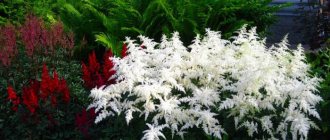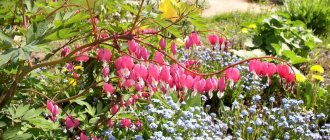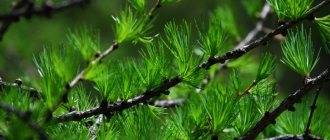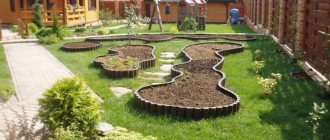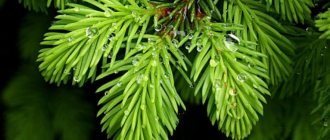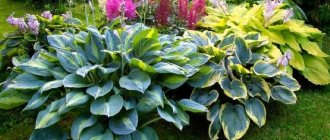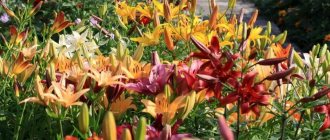Description of the flowering shrub Astilbe
The Astilbe plant belongs to the perennials of the Saxifraga family. In nature, they are found near water bodies, in forests, and in swampy areas. They grow mainly in the East and North America, but there are two species that thrive in Russia. Using this plant to decorate areas is quite simple. It is moisture-loving, loves partial shade, although it can easily take root on the sunny side. However, flowering in this case will not last a month, but 2-3 weeks. Loamy soil is preferable, as well as peaty, loose, fertile soil.
Astilbe simplefolia
The flower does not need support - the strong stems form a dense bush and hold the flowers well on them. The leaves have an unusual toothed shape and are mostly feathery in a bright dark or reddish green hue.
You may be interested in the article “The best perennial bush flowers for the garden“
general characteristics
Astilbe is a herbaceous plant with a developed woody root system. Perennial shoots can grow up to 2 m in height, but there are also miniature varieties up to only 8 cm. Matte dark leaves on long petioles acquire a dark green, bronze or reddish tint.
The peculiarity of astilbe is its expressive apical inflorescences up to 60 cm, collected from small lacy flowers. Shades vary from pink to lilac, from white to bright red, from lilac to violet.
Photo: domashniecvety.ru
Sometimes pyramidal, paniculate, diamond-shaped and even drooping inflorescences are found. The pyramidal side rods gradually decrease upward and diverge from the main axis at almost a right angle. In diamond-shaped ones they diverge under the sharp point: this is characteristic of Japanese astilbe.
In the garden, the flower harmonizes wonderfully with other shade-loving plants. For example, with hellebore, bergenia and podophyllum, or vice versa - with thin and graceful lilies of the valley, irises, tulips, and goat weed. Plant astilbe in monogroups near other shrubs, and individually they will dilute coniferous garden plantings.
Photo: pshlaw.ru
Classification of Astilbe plant species
Astilbe used in landscape design is classified by experienced gardeners according to several criteria:
- Height . Dwarf (0.3 m), short (up to 0.6 m), medium tall (up to 0.9 m), tall (up to 1.5 m). Some species reach 2 m, but they are used much less frequently in garden design.
- Type of inflorescences . Pyramid-shaped, rhombic, paniculate, arched, drooping.
- Aroma. Varieties such as Pink Lightining and Washington have a cherry scent, while Ellie and Weisse Gloria have a flowing honey scent.
Astilbe japonica - Flowering period . Early (Cologne, Europe), mid-early (Serenade, Fainel), late (Purpurkerze). Astilbe blooms from June to August, which allows you to form a successful composition with bright accents that constantly move throughout the summer.
- Colors. With red-pink, yellow-white tones it is called Arendsova. And hybrid medium and low-growing varieties have pink and purple colors. There are also lilac, carmine, burgundy and cherry varieties that fit harmoniously into the lush splendor of a garden of any stylistic orientation.
Astilbe chinensis
Varieties of astilbe (Astilbe) are diverse and this is its advantage over other ornamental plants. The most popular are Pumila, Bronze Elegance, Purpurea, Weisse Gloria. In total, there are more than 20 species of this plant, varying in flower shape, height and color. Therefore, astilbe can be used everywhere in landscape design - for any garden style.
Conclusion
Astilbe is an interesting and not difficult plant to grow. It does not require regular feeding throughout the season or a special watering schedule. The process of rejuvenating the bush and preparing it for winter is not complicated either.
At the same time, astilbe looks beautiful in the garden, filling shady areas where not all plants can grow. And even after flowering has ended, astilbe will delight you with its appearance, thanks to its openwork leaves and dry inflorescences.
Astilbe shrub: planting and care in open ground
Let us describe the main details in the process of growing this amazing shrub in the garden.
Where to plant
Astilbes thrive in moist, well-drained soils with average humidity. If you have a shady area that could use some color and texture, Astilbes are a great choice. These beauties burn in full sun and prefer areas of light to moderate shade where many other flowers typically fail to survive.
When to plant
Plant Astilbe in spring or fall, depending on your local climate. It is better to avoid summer planting, as shrubs do not tolerate dry soil well.
How to plant Astilbe
Prepare the planting site so that the soil is well-drained. If puddles remain 5-6 hours after heavy rain in your chosen location, choose a different location or amend the soil with more peat moss, perlite and coarse sand to improve drainage.
Dig holes at a distance of 30 - 60 cm from each other and place the Astilbes in the ground, slightly expanding the roots. Water well after planting to gently saturate the soil and distribute it around the roots.
- in spring, nitrogenous mineral fertilizers or compost,
- in autumn - potassium-phosphorus mixtures.
Every year, the area where this flower grows is covered with soil and mulched so that the root system does not become frozen in winter and the plant does not begin to lean to the side.
Abundant watering in summer and fertilizing will ensure good flowering throughout the month. The root system practically does not require shelter for the winter. This is a frost-resistant species that can withstand down to -35°C. But you can protect it from freezing in a more severe climate with the help of mulch. Even cut dry logs or chopped grass will become it.
Pest and disease control
Astilbe is one of those rare, but very convenient garden plants that are practically not susceptible to diseases and pests. Sometimes rhizomes are attacked by a root-knot nematode, which does not respond to classical insecticides. In this case, the diseased bushes will have to be removed along with the contaminated soil.
The second problem is slobbering pennix, which can be noticed if the leaves begin to grow less densely and slowly. For prevention, it is advisable to collect pests manually and carry out regular treatment.
Photo: commons.wikimedia.org
Blueberries: varieties, care and cultivation (photo)
How to care for Astilbe in the garden
Expect root growth to begin almost immediately after planting. In warm climates, the top shoots will form within a few weeks. In cool climates, seedlings appear in the spring. If you are planting Astilbe in the fall, do this procedure 6 weeks before frost. This gives fall-planted perennials time to strengthen their roots and reduces the risk of frostbite.
Watering
The peculiarity of Astilbe is that young roots make their way to the top layer of soil, and older roots gradually die off. Over time, the root system becomes deprived of nutrients, so hilling is especially important for this flower. Do not allow the soil to dry out: timely watering is one of the mandatory rules for caring for shrubs.
In addition, mulching will not only protect the root system from overheating, but will also maintain soil moisture and get rid of weeds without the need for frequent loosening of the soil. Astilbe requires good moisture, depending on the type and variety; regular and abundant watering is also required during the formation of inflorescences. In severe drought, water the plant twice a day - early in the morning and in the evening.
Fertilizer
Apply fertilizing at least twice a season. Use a slow-release fertilizer in early spring and give them an additional dose after six to eight weeks. You can use an all-purpose fertilizer containing equal parts nitrogen, phosphorus and potassium, or choose a fertilizer with a higher content of nitrogen and phosphorus. Phosphorus helps with root and flower development, while nitrogen promotes full, vibrant foliage.
How and when to prune Astilbe?
You can decide whether Astilbe is pruned based on your own taste preferences. If the garden design involves the use of its luxurious cherry and dark green foliage, then astilbe is not pruned in the fall. The decorative nature of the form will delight the owners even in winter. But be sure to perform this procedure after flowering - to remove withered branches. Then it will be easier for the culture to regain strength before wintering. Pruning is done in spring or autumn. This is done to remove dry pagons.
Shrub transplantation
Without replanting, Astilbe can grow for 5-7 years, but with good care and timely application of fertilizers, it can grow in one place for up to twenty years.
You can transplant part of the bush at 4-5 years of the plant’s life. This will also renew the mother bush. If this is not done, already from the sixth year of growth in one place, the decorative effect is lost, the flowering becomes less bright.
The best time to replant astilbe is May. Using your own planting material, you can decorate all corners of your garden.
Top dressing
Astilbe is fed three times a year: in spring, summer and autumn.
Spring feeding is aimed at stimulating plant growth, the appearance of foliage, shoot development and budding. At this time, nitrogen fertilizers are used.
In summer, fertilizing is applied before flowering begins. The fact is that the formation of flowers is a very energy-consuming process for a plant. And he needs additional feeding. Potash fertilizers are used. For example, you can add a solution of 2 tbsp. potassium nitrate and a bucket of water.
The purpose of autumn feeding is to prepare the plant for wintering. At this time, phosphorus fertilizers (for example, superphosphate) are applied.
IMPORTANT! It is best to apply fertilizing after watering. Then the soil needs to be loosened and mulched.
Astilbe in garden decoration
Finding a suitable site for this plant is not difficult - it will perfectly complement a flower garden, become a hedge or border, or decorate an artificial pond. Astilbe is planted both in groups and individually, using seeds or cuttings. The only restriction in the neighborhood is on moisture-loving thujas, birches, rhododendrons, maples and non-frost-resistant roses.
The luxury of colors and shapes, different heights allow us to classify the crop as a universal species, suitable for decorating all areas without exception. Astilbe in landscape design can play both a key role, making bright accents, and a secondary one, becoming a background for other plants, masking unsightly buildings.
Choosing a landing site
Most varieties prefer moist soil and shaded areas. An overly lit space will shorten the flowering period by about two weeks. It is optimal to choose the following varieties for growing in open areas:
- Strausfeder;
- Frieda Clapp;
- dwarf Chinese astilbe;
- Diamond.
Attention! The soil under the crop must be constantly moist.
Insufficient rainfall and a region with a dry climate make it necessary to take care of regular watering. Sometimes the procedure is carried out twice a day - early in the morning and in the evening after sunset.
Loose soil with neutral acidity is the optimal conditions for growing astilbe. Excessively dense soil structure is corrected by mulching with peat or adding sawdust and sand. Lime will help reduce acidity.
The bank of a stream, a pond, or the design of a space near a waterfall are optimal areas for use on an astilbe plot. If the soil has a sufficient degree of natural moisture, the crop is fed with mineral compounds with the addition of nitrogen substances. When the plant fades, it’s time to apply potash and phosphorus fertilizers. If the soil is dry, mineral fertilizers are replaced by mulching with peat or compost.

